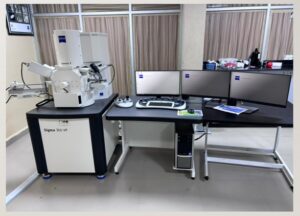NBRRI Scanning Electron Microscope (SEM): Detailed Imaging and Analysis of Construction Materials
 NBRRI Scanning Electron Microscope (SEM)
NBRRI Scanning Electron Microscope (SEM) is a highly sophisticated imaging instrument used by the
Nigerian Building and Road Research Institute (NBRRI) for examining the microstructure of construction materials at an extremely high resolution. SEM technology provides detailed information about the surface morphology, composition, and structural features of materials such as concrete, cement, soil, and other aggregates, making it indispensable for quality control, research, and development in the construction industry.
Function
The primary function of the NBRRI SEM is:
- To produce high-resolution, magnified images of material surfaces, allowing for in-depth analysis of their microstructural properties and surface morphology.
By scanning a focused beam of electrons across the surface of a sample, the SEM generates images that reveal detailed textures, cracks, pores, and other structural features that affect the material’s performance and durability. This capability is essential in analyzing and improving construction materials, ensuring they meet rigorous standards for use in infrastructure projects.
Applications
The NBRRI Scanning Electron Microscope is applied in several key areas related to material analysis and quality control:
- Microstructure Analysis of Cement and Concrete:
SEM allows researchers to analyze the microscopic structure of cement and concrete, including hydration products, air voids, and particle distribution. This information is crucial for understanding material strength, durability, and failure mechanisms.
- Soil and Aggregate Examination:
The SEM is used to examine soil and aggregate particles, revealing important details about particle shape, size, and texture. These properties influence soil compaction, stability, and load-bearing capacity, which are critical in geotechnical engineering and foundation construction.
- Failure Analysis in Construction Materials:
When construction materials fail, SEM is invaluable in identifying microscopic causes such as cracking, delamination, or material contamination. By understanding these causes, engineers can improve material formulations and manufacturing processes to prevent future failures.
- Research and Development of New Materials:
In research settings, SEM is used to study the effects of additives and novel materials on the microstructure of construction materials. This analysis supports the development of advanced, high-performance materials tailored for specific environmental and structural requirements.
How It Works
The NBRRI Scanning Electron Microscope works by scanning an electron beam over a sample to produce detailed, high-resolution images:
- Sample Preparation:
Depending on the material, the sample may be cleaned, coated with a conductive layer (often gold or carbon), and mounted on a stub to prevent electron charging and to achieve clear imaging.
- Electron Beam Scanning:
The SEM emits a focused electron beam that scans across the sample’s surface. When the electrons interact with the sample, they emit signals, including secondary and backscattered electrons.
- Signal Detection and Image Formation:
These emitted signals are collected by detectors and processed to form a high-resolution image of the sample’s surface, showing details at the micro and even nanometer scale.
- Elemental Analysis (Optional):
Many SEM systems are equipped with Energy Dispersive X-ray Spectroscopy (EDS) capabilities, allowing researchers to perform elemental analysis and determine the chemical composition of the sample in conjunction with structural imaging.
This process enables precise imaging and material analysis that is essential in quality control, failure analysis, and research applications.
Benefits of the NBRRI Scanning Electron Microscope (SEM)
- Enhanced Understanding of Material Microstructure: SEM provides insights into the microscopic characteristics of materials, which directly influence their performance, durability, and strength.
- Improved Quality Control: By identifying structural imperfections at a microscopic level, SEM helps ensure that only high-quality materials are used in construction projects, contributing to safer, more reliable infrastructure.
- Supports Innovation in Material Science: SEM enables researchers to study new materials and additives at a micro level, driving advancements in material properties, performance, and sustainability.
In summary, the
NBRRI Scanning Electron Microscope (SEM) is a powerful tool for examining the intricate details of construction materials at a microscopic scale. Its ability to produce high-resolution images and conduct elemental analysis aids in quality assurance, material development, and failure analysis, ultimately enhancing the safety, durability, and innovation in construction projects.
 NBRRI Scanning Electron Microscope (SEM) is a highly sophisticated imaging instrument used by the Nigerian Building and Road Research Institute (NBRRI) for examining the microstructure of construction materials at an extremely high resolution. SEM technology provides detailed information about the surface morphology, composition, and structural features of materials such as concrete, cement, soil, and other aggregates, making it indispensable for quality control, research, and development in the construction industry.
NBRRI Scanning Electron Microscope (SEM) is a highly sophisticated imaging instrument used by the Nigerian Building and Road Research Institute (NBRRI) for examining the microstructure of construction materials at an extremely high resolution. SEM technology provides detailed information about the surface morphology, composition, and structural features of materials such as concrete, cement, soil, and other aggregates, making it indispensable for quality control, research, and development in the construction industry.
